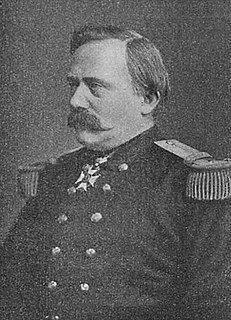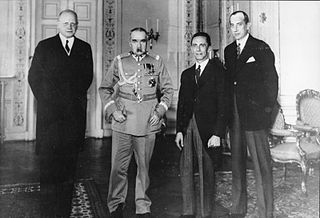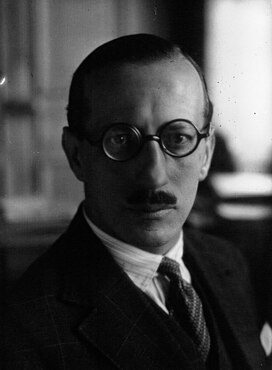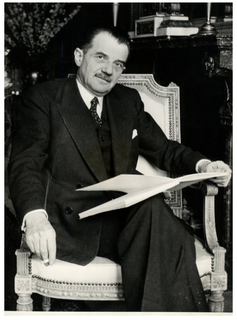
The Maginot Line, named after the French Minister of War André Maginot, is a line of concrete fortifications, obstacles and weapon installations built by France in the 1930s to deter invasion by Germany and force them to move around the fortifications. The Maginot Line was impervious to most forms of attack. In consequence, the Germans invaded through the Low Countries in 1940, passing it to the north. The line, which was supposed to be fully extended further towards the west to avoid such an occurrence, was finally scaled back in response to demands from Belgium. Indeed, Belgium feared it would be sacrificed in the event of another German invasion. The line has since become a metaphor for expensive efforts that offer a false sense of security.

The Pact of Steel, known formally as the Pact of Friendship and Alliance between Germany and Italy, was a military and political alliance between Italy and Germany.

The Locarno Treaties were seven agreements negotiated at Locarno, Switzerland, during 5 to 16 October 1925 and formally signed in London on 1 December, in which the First World War Western European Allied powers and the new states of Central and Eastern Europe sought to secure the post-war territorial settlement, in return for normalising relations with the defeated German Reich. It also stated that Germany would never go to war with the other countries. Locarno divided borders in Europe into two categories: western, which were guaranteed by the Locarno Treaties, and eastern borders of Germany with Poland, which were open for revision.

Ferdinand Foch was a French general and military theorist who served as the Supreme Allied Commander during the First World War. An aggressive, even reckless commander at the First Marne, Flanders and Artois campaigns of 1914–1916, Foch became the Allied Commander-in-Chief in late March 1918 in the face of the all-out German spring offensive, which pushed the Allies back using fresh soldiers and new tactics that trenches could not contain. He successfully coordinated the French, British and American efforts into a coherent whole, deftly handling his strategic reserves. He stopped the German offensive and launched a war-winning counterattack. In November 1918, Marshal Foch accepted the German cessation of hostilities and was present at the Armistice of 11 November 1918.
The events preceding World War II in Europe are closely tied to the bellicosity of Italy, Germany and Japan, as well as the Great Depression. The peace movement led to appeasement and disarmament.
A non-aggression pact or neutrality pact is a treaty between two or more states/countries that includes a promise by the signatories not to engage in military action against each other. Such treaties may be described by other names, such as a treaty of friendship or non-belligerency, etc. Leeds, Ritter, Mitchell, & Long (2002) distinguish between a non-aggression pact and a neutrality pact. They posit that a non-aggression pact includes the promise not to attack the other pact signatories, whereas a neutrality pact includes a promise to avoid support of any entity that acts against the interests of any of the pact signatories. The most readily recognized example of the aforementioned entity is another country, nation-state, or sovereign organization that represents a negative consequence towards the advantages held by one or more of the signatory parties.

Henri-Alexis Brialmont, nicknamed The Belgian Vauban after the French military architect, was a Belgian army officer, politician and writer of the 19th century, best known as a military architect and designer of fortifications. Brialmont qualified as an officer in the Belgian army engineers in 1843 and quickly rose up the ranks. He served as a staff officer, and later was given command of the district of the key port of Antwerp. He finished his careers as Inspector-General of the Army. Brialmont was also an active pamphleteer and political campaigner and lobbied through his career for reform and expansion of the Belgian military and was also involved in the foundation of the Congo Free State.
The Franco-Polish Alliance was the military alliance between Poland and France that was active between the early 1920s and the outbreak of the Second World War. The initial agreements were signed in February 1921 and formally took effect in 1923. During the interwar period the alliance with Poland was one of the cornerstones of French foreign policy.

The German–Polish declaration of non-aggression, also known as the German–Polish non-aggression pact, was a non-aggression agreement between Nazi Germany and the Second Polish Republic that was signed on 26 January 1934 in Berlin. Both countries pledged to resolve their problems by bilateral negotiations and to forgo armed conflict for a period of 10 years. The agreement effectively normalised relations between Poland and Germany, which had been strained by border disputes arising from the territorial settlement in the Treaty of Versailles. Germany effectively recognised Poland's borders and moved to end an economically-damaging customs war between the two countries that had taken place over the previous decade.
The military alliance between the United Kingdom and Poland was formalised by the Anglo-Polish Agreement in 1939, with subsequent addenda of 1940 and 1944, for mutual assistance in case of a military invasion from Nazi Germany, as specified in a secret protocol.

The Koningshooikt—Wavre Line, abbreviated to KW Line and often known as the Dyle Line after the Dijle (Dyle) river, was a 60 kilometres (37 mi)-long fortified line of defence prepared by the Belgian Army between Koningshooikt and Wavre which was intended to protect Brussels from a possible German invasion. Construction on the KW Line began in September 1939 after World War II had begun but while Belgium itself remained a neutral state. It was subsequently extended southwards from Wavre towards Namur. The line itself consisted of bunkers, anti-tank ditches, and barricades including so-called Cointet-elements and played a key role in Allied strategy during the German invasion of Belgium in May 1940. However, its role in the actual fighting was ultimately minimal. In 2009 an inventory of surviving emplacements was begun.

The remilitarization of the Rhineland began on 8 March 1936, when German military forces entered the Rhineland, which directly contravened the Treaty of Versailles and the Locarno Treaties. Neither France nor Britain was prepared for a military response, so they did not act. After 1939 commentators often said that a strong military move in 1936 might have ruined Hitler's expansionist plans. However, recent historiography agrees that both public and elite opinion in Britain and France strongly opposed a military intervention, and neither had an army prepared to move in.
The Iberian Pact or Peninsular Pact, formally the Portuguese–Spanish Treaty of Friendship and Non-Aggression, was a non-aggression pact that was signed at Lisbon, just a few days before the end of the Spanish Civil War, on 17 March 1939 by Portuguese Prime Minister António de Oliveira Salazar, representing Portugal, and Ambassador Nicolás Franco, representing Spain. The treaty was ratified on 25 March 1939.
The Franco-Soviet Treaty of Mutual Assistance was a bilateral treaty between France and the Soviet Union with the aim of enveloping Nazi Germany in 1935 to reduce the threat from Central Europe. It was pursued by Maxim Litvinov, the Soviet foreign minister, and Louis Barthou, the French foreign minister, who was assassinated in October 1934, before negotiations had been finished. His successor, Pierre Laval, was sceptical of the desirability and of the value of an alliance with the Soviet Union. However, after the declaration of German rearmament in March 1935, the French government forced the reluctant foreign minister to complete the arrangements with Moscow that Barthou had begun.

René Massigli was a French diplomat who played a leading role as a senior official at the Quai d'Orsay and was regarded as one of the leading French experts on Germany, which he greatly distrusted.

Belgium was not a belligerent in the Franco-Prussian War (1870–1871) but was heavily influenced by the social and political effects of the conflict. An invasion of Belgian territory by either side was widely feared in 1870 and the Belgian Army was mobilised. The inadequacies which this revealed in Belgium's military and defensive preparations led to calls to reform the system of conscription and for a programme of fortification-building which would greatly influence the early phases of World War I.
The History of French foreign relations covers French diplomacy and foreign relations down to 1980. For the more recent developments, see Foreign relations of France.

Louis Félix Thomas Maurin was a French army general who was twice Minister of War in the 1930s. Before and during World War I (1914–18) he was a strong advocate of motorization. In the inter-war period from 1919 to 1939 he advocated a policy of passive defense against the growing German threat. He thought that with all the money that had been spent on the Maginot Line fortifications it would be madness to go on the offensive. He saw little value in tanks as a weapon. He advised against a limited military reaction when Germany reoccupied the Rhineland in March 1936, calling for general mobilization or nothing. He did not consider that the 1936 pact with Russia would help France militarily.
The Bérard-Jordana Agreement, also called Berard-Jordan Agreement in English, was a political treaty signed by France and Spain in Burgos on 25 February 1939. Its name is based on the two principal signatories, Léon Bérard for France and General Jordana for Spain.

Charles Henri Raymond Brugère was a French diplomat.












